Sie möchten einen sicheren Ort, an dem Sie mit Ihrer WordPress-Website experimentieren können, ohne Angst haben zu müssen, etwas auf Ihrer Live-Site kaputt zu machen?
Das Verschieben Ihrer WordPress-Site auf einen lokalen Server auf Ihrem Computer ist unserer Meinung nach die perfekte Lösung, insbesondere für Entwickler, Designer oder WordPress-Anfänger.
Die Installation von WordPress auf Ihrem Computer (lokaler Server) ermöglicht es Ihnen, WordPress einfach zu erlernen und Dinge zu testen. Wenn Sie eine Live-WordPress-Site auf einen lokalen Server verschieben, können Sie mit denselben Daten experimentieren wie mit Ihrer Live-Site.
In diesem Artikel zeigen wir Ihnen, wie Sie eine Live-WordPress-Site ganz einfach auf einen lokalen Server verschieben können.
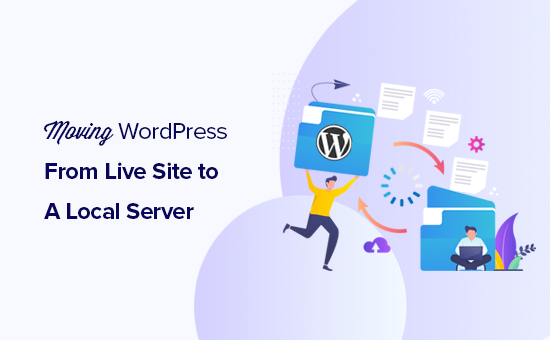
Warum und für wen ist es sinnvoll, eine WordPress-Website auf einen lokalen Server zu verschieben?
Wenn Sie bereits seit einiger Zeit eine WordPress-Website betreiben, möchten Sie vielleicht neue Themes oder ein Plugin ausprobieren. Wenn Sie dies jedoch auf einer Live-Website tun, kann dies zu einer schlechten Benutzererfahrung für Ihre Benutzer führen.
Um dies zu vermeiden, erstellen viele Benutzer eine Kopie ihrer WordPress-Website auf einem lokalen Server, um neue Themes und Plugins zu testen oder Entwicklungstests durchzuführen.
So können Sie Ihr Thema mit all Ihren Inhalten einrichten und alle Funktionen testen, ohne sich Sorgen machen zu müssen, dass Ihre Website kaputt geht. Viele Benutzer kopieren ihre Website auf einen lokalen Server, um ihre WordPress- und Programmierkenntnisse mit echten Website-Daten zu üben.
Auch wenn Sie alle Tests mit Dummy-Inhalten in WordPress durchführen können, geben Ihnen die Daten einer echten Website eine bessere Vorstellung davon, wie diese Änderungen auf Ihrer Live-Site aussehen werden.
Vorbereiten der Verschiebung einer lokalen Site auf einen lokalen Server
Zunächst müssen Sie sicherstellen, dass Sie immer ein Backup Ihrer WordPress-Website erstellen. Es gibt mehrere großartige WordPress-Backup-Plugins, die Sie verwenden können.
Zweitens müssen Sie eine lokale Serverumgebung auf Ihrem Computer installieren. Sie können WAMP für Windows und MAMP für Mac verwenden. Sobald Sie die Umgebung eingerichtet haben, müssen Sie mit phpMyAdmin eine neue Datenbank erstellen.
Rufen Sie einfach die folgende URL in Ihrem Browser auf, um phpMyAdmin zu starten.
http://localhost/phpmyadmin/
http://localhost:8080/phpmyadmin/
Hier müssen Sie auf die Registerkarte “Datenbanken” klicken und eine neue Datenbank erstellen. Diese Datenbank benötigen Sie später, um Ihre Live-Site-Daten zu entpacken.

Sie sind nun bereit, Ihre Live-WordPress-Site auf einen lokalen Server zu verschieben.
Methode 1. Verschieben einer Live-WordPress-Site auf einen lokalen Server mit einem Plugin
Diese Methode ist einfacher und wird für alle Benutzer empfohlen.
Als Erstes müssen Sie das Duplicator-Plugin installieren und aktivieren. Weitere Details finden Sie in unserer Schritt-für-Schritt-Anleitung für die Installation eines WordPress-Plugins.
Mit Duplicator können Sie ganz einfach ein Duplikatpaket Ihrer gesamten Website erstellen. Es kann verwendet werden, um Ihre WordPress-Website an einen neuen Standort zu verschieben, und kann auch als Backup-Plugin verwendet werden.
Hinweis: Es gibt eine kostenlose Version von Duplicator, mit der Sie loslegen können. Duplicator Pro bietet jedoch unbegrenzte Backups und erweiterte Funktionen.
Nach der Aktivierung gehen Sie in Ihrer WordPress-Admin-Seitenleiste auf Duplicator Pro ” Backups. Um ein neues Paket zu erstellen, müssen Sie auf die Schaltfläche “Neu hinzufügen” klicken.
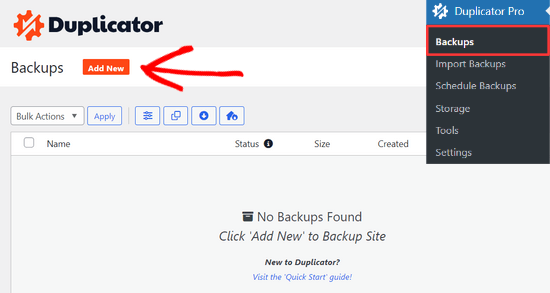
Duplicator startet dann den Sicherungsassistenten.
Zunächst müssen Sie einen Namen für Ihr Sicherungspaket eingeben. Sie können auch die dynamischen Tags verwenden, um automatisch ein Namensformat wie das Datum und den Titel Ihrer Website zu erstellen.

Erweitern Sie dann den Abschnitt “Speicher” und wählen Sie einen Speicherort.
Für dieses Lernprogramm verwenden wir den Standardspeicherort. Sie können auf den Link “Speicher hinzufügen” klicken, um einen neuen Speicherort hinzuzufügen, z. B. Dropbox oder Google Drive, wenn Sie möchten.
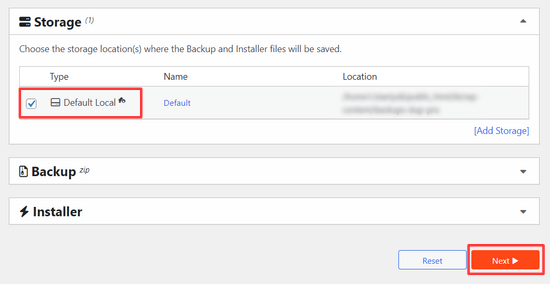
Klicken Sie auf die Schaltfläche “Weiter”, um fortzufahren.
Das Plugin scannt dann Ihre Website und führt einige Hintergrundprüfungen durch. Es zeigt Ihnen dann eine Zusammenfassung dieser Überprüfungen.
Wenn alles gut aussieht, klicken Sie auf die Schaltfläche“Sicherung erstellen“, um fortzufahren.
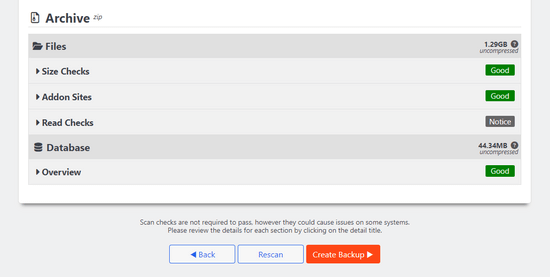
Duplicator wird nun Ihr Website-Paket erstellen.
Danach sehen Sie eine Zip-Datei, die alle Daten Ihrer Website enthält, und eine Installationsdatei. Sie müssen beide Dateien auf Ihren Computer herunterladen.
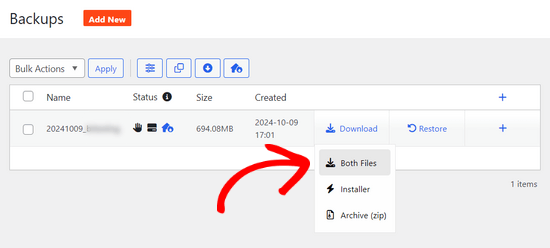
Jetzt können Sie diese Dateien entpacken und auf Ihrem lokalen Server installieren.
Zunächst müssen Sie einen neuen Ordner im Stammverzeichnis Ihres lokalen Servers erstellen. Dies ist der Ordner, in dem Ihr lokaler Server alle Websites speichert.
Wenn Sie zum Beispiel MAMP verwenden, ist es der Ordner /Applications/MAMP/htdocs/. Wenn Sie jedoch WAMP verwenden, ist es der Ordner C:\wamp\www\.
Innerhalb dieses Ordners können Sie für jede neue Website, die Sie importieren oder auf Ihrem lokalen Server erstellen möchten, neue Ordner anlegen.
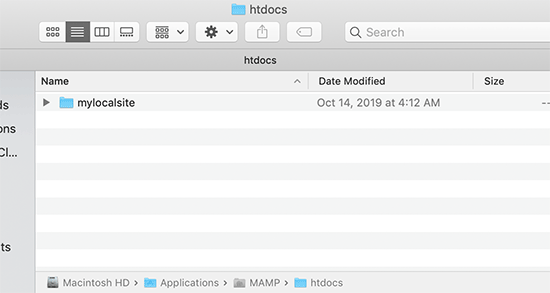
Danach müssen Sie den Ordner öffnen, den Sie für Ihre lokale Website erstellt haben, und dann sowohl die Archiv-Zip-Datei als auch das Installations-Skript, das Sie zuvor heruntergeladen haben, kopieren und einfügen.
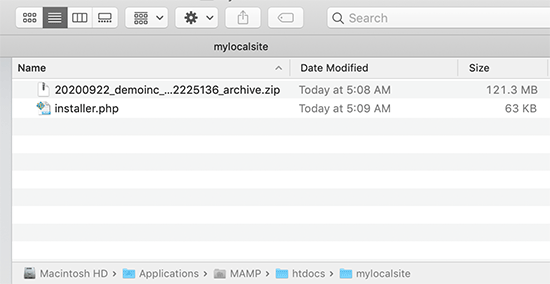
Um die Installation durchzuführen, müssen Sie das Skript installer.php in Ihrem Webbrowser öffnen.
Wenn Sie zum Beispiel beide Dateien in den Ordner /mylocalsite/ eingefügt haben, können Sie sie in Ihrem Browser unter http://localhost/mylocalsite/installer.php aufrufen .
Das Duplicator-Installationsskript sieht nun wie folgt aus:
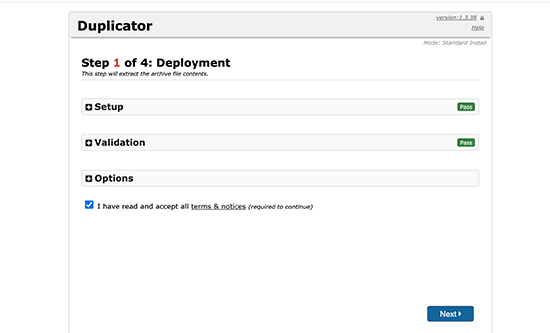
Klicken Sie auf die Schaltfläche “Weiter”, um fortzufahren.
Duplicator entpackt nun die Archiv-Zip-Datei und fordert Sie auf, die Datenbankinformationen Ihrer lokalen Website einzugeben. Dies ist die Datenbank, die Sie zuvor erstellt haben.
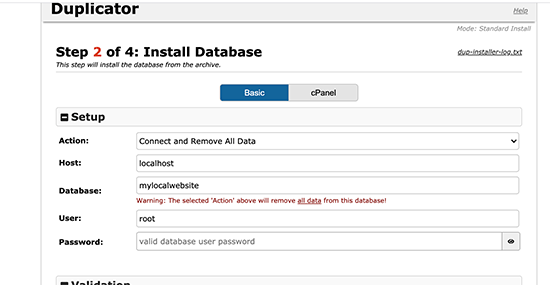
Der Servername ist fast immer localhost und der Benutzername ist root. In den meisten Fällen hat Ihre lokale Serverinstallation kein Passwort für root festgelegt, so dass Sie dieses leer lassen können.
Unten auf der Seite finden Sie eine Schaltfläche “Datenbank testen”, mit der Sie sicherstellen können, dass Ihre Datenbankinformationen korrekt sind.
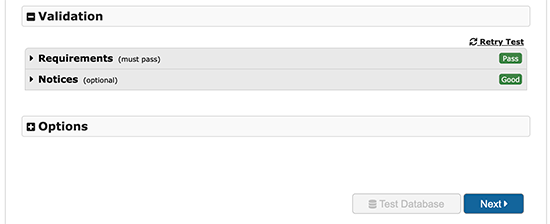
Wenn alles gut aussieht, klicken Sie auf die Schaltfläche “Weiter”, um fortzufahren.
Duplicator wird nun Ihre WordPress-Datenbank importieren. Danach werden Sie aufgefordert, die neuen Website-Informationen, die automatisch erkannt wurden, zu überprüfen.
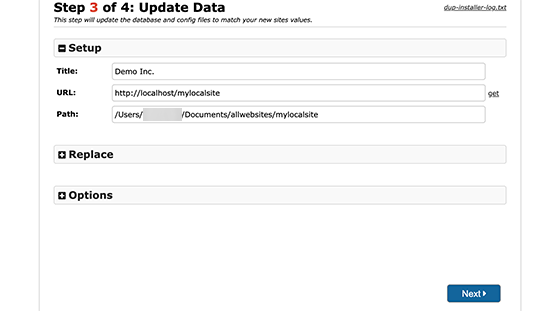
Klicken Sie auf die Schaltfläche “Weiter”, um fortzufahren.
Duplicator beendet nun die Einrichtung und zeigt Ihnen eine Schaltfläche an, mit der Sie sich bei Ihrer lokalen Website anmelden können. Sie verwenden denselben WordPress-Benutzernamen und dasselbe Passwort, das Sie auf Ihrer Live-Site verwenden.
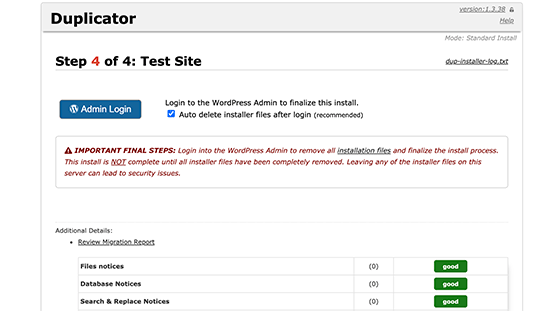
Das war’s. Sie haben Ihre Live-Site erfolgreich auf den lokalen Server verschoben.
Methode 2. Manuelles Verschieben einer Live-WordPress-Site auf einen lokalen Server
Sollte das Plugin bei Ihnen nicht funktionieren, können Sie Ihre Live-Site jederzeit manuell auf einen lokalen Server verschieben. Als Erstes müssen Sie Ihre Website manuell von Ihrem WordPress-Hosting-Konto aus sichern.
Schritt 1. Exportieren Sie die WordPress-Datenbank Ihrer Live-Site
Um die WordPress-Datenbank Ihrer Live-Site zu exportieren, müssen Sie sich in Ihrem cPanel-Dashboard anmelden und auf phpMyAdmin klicken.
Hinweis: Wir zeigen Screenshots vom Bluehost-Dashboard.
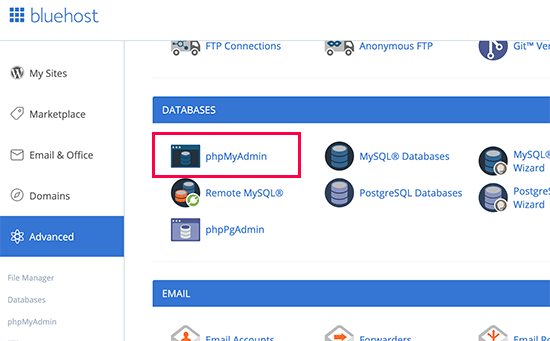
In phpMyAdmin müssen Sie die Datenbank auswählen, die Sie exportieren möchten, und dann oben auf die Registerkarte “Export” klicken.
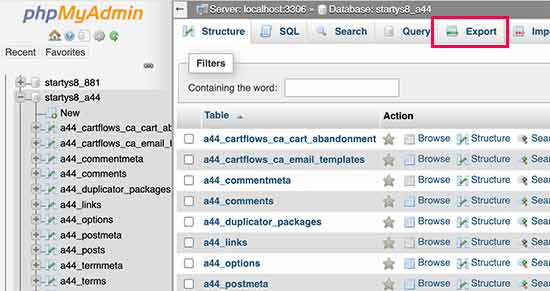
phpMyAdmin fordert Sie nun auf, entweder die schnelle oder die benutzerdefinierte Exportmethode zu wählen. Wir empfehlen, die benutzerdefinierte Methode zu verwenden und zip als Komprimierungsmethode zu wählen.
Manchmal können WordPress-Plugins ihre eigenen Tabellen in Ihrer WordPress-Datenbank erstellen. Wenn Sie dieses Plugin nicht mehr verwenden, können Sie mit der benutzerdefinierten Methode diese Tabellen ausschließen.
Lassen Sie die restlichen Optionen unverändert und klicken Sie auf die Schaltfläche “Go”, um Ihre Datenbanksicherung im Zip-Format herunterzuladen.
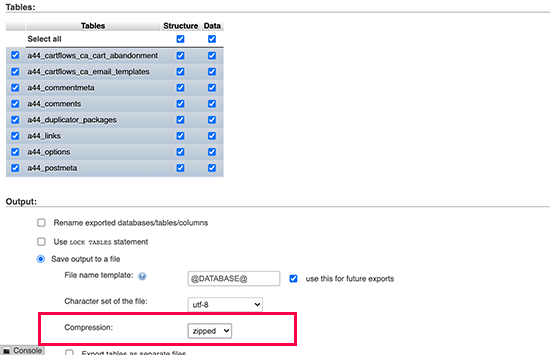
phpMyAdmin wird nun Ihre Datenbankdatei herunterladen. Weitere Details finden Sie in unserer Anleitung, wie Sie Ihre WordPress-Datenbank manuell sichern.
Schritt 2. Laden Sie alle Ihre WordPress-Dateien herunter
Der nächste Schritt besteht darin, Ihre WordPress-Dateien herunterzuladen. Dazu müssen Sie mit einem FTP-Client eine Verbindung zu Ihrer WordPress-Website herstellen.
Sobald die Verbindung hergestellt ist, wählen Sie alle Ihre WordPress-Dateien aus und laden Sie sie auf Ihren Computer herunter.
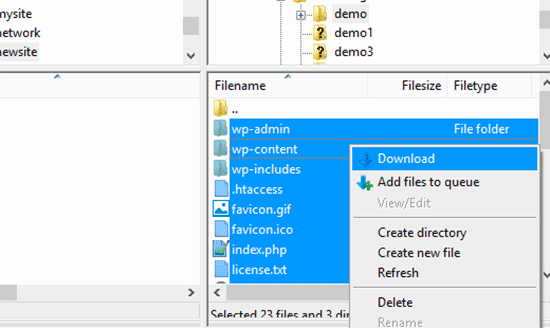
Schritt 3. Importieren Sie Ihre WordPress-Dateien und Datenbank auf den lokalen Server
Nachdem Sie Ihre WordPress-Dateien heruntergeladen haben, müssen Sie einen Ordner auf Ihrem lokalen Server erstellen, in den Sie die lokale Website importieren möchten.
Wenn Sie WAMP verwenden, sollten Sie einen Ordner im Ordner C:\wamp\www\ für Ihre lokale Website erstellen. MAMP-Benutzer müssen einen Ordner im Ordner /Applications/MAMP/htdocs/ erstellen.
Kopieren Sie anschließend einfach Ihre WordPress-Dateien und fügen Sie sie in den neuen Ordner ein.
Als nächstes müssen Sie Ihre WordPress-Datenbank importieren. Öffnen Sie einfach den phpMyAdmin auf Ihrem lokalen Server, indem Sie die folgende URL aufrufen:
http://localhost/phpmyadmin/
Da Sie die Datenbank bereits zuvor erstellt haben, müssen Sie sie nun auswählen und dann oben auf die Registerkarte “Importieren” klicken.
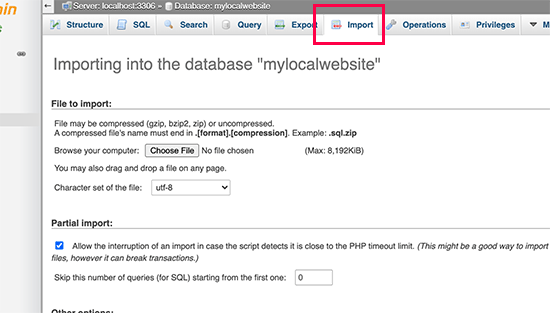
Klicken Sie auf die Schaltfläche “Datei auswählen”, um die im ersten Schritt heruntergeladene Datenbankexportdatei auszuwählen und hochzuladen. Klicken Sie anschließend auf die Schaltfläche “Go” unten auf der Seite.
phpMyAdmin wird nun Ihre WordPress-Datenbank entpacken und importieren.
Nun, da Ihre Datenbank eingerichtet ist, müssen Sie die URLs innerhalb Ihrer WordPress-Datenbank aktualisieren, die auf Ihre Live-Site verweisen.
Sie können dies tun, indem Sie eine SQL-Abfrage in phpMyAdmin ausführen. Vergewissern Sie sich, dass Sie die Datenbank Ihrer lokalen Website ausgewählt haben, und klicken Sie dann auf SQL.
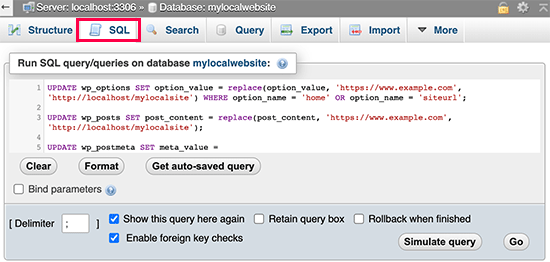
Kopieren Sie diesen Code in den SQL-Bildschirm von phpMyAdmin und fügen Sie ihn ein. Ersetzen Sie dabei example.com durch die URL Ihrer Live-Site und http://localhost/mylocalsite durch die lokale Server-URL Ihrer Site.
UPDATE wp_options SET option_value = replace(option_value,'https://www.example.com','http://localhost/mylocalsite') WHERE option_name ='home'OR option_name ='siteurl';UPDATE wp_posts SET post_content = replace(post_content,'https://www.example.com','http://localhost/mylocalsite');UPDATE wp_postmeta SET meta_value = replace(meta_value,'https://www.example.com','http://localhost/mylocalsite');
Diese Abfrage ersetzt Verweise auf die URL Ihrer Live-Site aus der Datenbank und ersetzt sie durch die URL des lokalen Hosts.
Schritt 4. Aktualisieren der Datei wp-config.php
Der letzte Schritt ist die Aktualisierung der Datei wp-config.php Ihrer lokalen Website. Diese Datei enthält WordPress-Einstellungen, einschließlich der Verbindung zu Ihrer WordPress-Datenbank.
Gehen Sie einfach zu dem Ordner, in dem Sie WordPress auf Ihrem lokalen Server installiert haben, und öffnen Sie die Datei wp-config.php in einem Texteditor wie Notepad.
Ersetzen Sie den Namen der Datenbank durch den Namen, den Sie in phpMyAdmin auf Ihrem localhost erstellt haben.
Danach ersetzen Sie den Datenbank-Benutzernamen durch Ihren lokalen MySQL-Benutzernamen, normalerweise ist das root. Wenn Sie ein Passwort für den MySQL-Benutzer root auf Ihrem localhost festgelegt haben, geben Sie dieses Passwort ein. Andernfalls lassen Sie es leer und speichern Sie Ihre Änderungen.
/** The name of the database for WordPress */define('DB_NAME','database_name_here');/** MySQL database username */define('DB_USER','username_here');/** MySQL database password */define('DB_PASSWORD','password_here');
Sie können nun Ihre lokale Website in einem Browserfenster besuchen, indem Sie die URL wie folgt eingeben:
http://localhost/mylocalsite/
Ersetzen Sie “mylocalsite” durch den Namen des Ordners, in den Sie Ihre WordPress-Dateien kopiert haben.
Das war’s. Ihre WordPress-Live-Site wird nun auf Ihren lokalen Server kopiert.
Wir hoffen, dass dieser Artikel Ihnen geholfen hat zu erfahren, wie Sie eine Live-WordPress-Site einfach auf einen lokalen Server verschieben können. Vielleicht interessiert Sie auch unsere Anleitung, wie Sie ganz einfach eine Staging-Site für WordPress zum Testen erstellen können, oder wie Sie eine WordPress-Site vom lokalen Server auf die Live-Site verschieben.
Wenn Ihnen dieser Artikel gefallen hat, dann abonnieren Sie bitte unseren YouTube-Kanal für WordPress-Videotutorials. Sie können uns auch auf Twitter und Facebook finden.





Joseph
Hi, just came across this tutorial today, I found out about some of the steps from other tutorials, but my problem is with the SQL Query. I get the error # MySQL returned an empty result set (i.e. zero rows). I followed all your steps about changing site names etc but cant work this one out and so obviously i cant then connect to the local site. I used the Duplicator before on another site but it wont work so good on this one because of all the images on my photo site, ie timeout issues. Kinda going around in circles here, so help would be good.
Thanks,
Joseph
Yarina
Joseph, check that the table prefix on the SQL tables you are working with are the same. I had this issue before when I didn’t realize that the theme I was copying from had a non typical prefix (wp_extra-text instead of just wp_). When you create the new db on phpMyAdmin, make sure that the prefix matches that of the old db. Hope this helps!
Alan OldStudent
I tried using Duplicator, and that worked with one minor glitch. So then I dropped the database and tried the manual method. All steps proceeded well until it came time to import. I recreated the database and went to import. Afterwards, I got this error message: “#1064 – You have an error in your SQL syntax; check the manual that corresponds to your MySQL server version for the right syntax to use near ‘default’, ‘This is the default profile, used when no profile is specified.’, ‘a:’ at line 7”
To me that looks like gobbledygook. Do you have any idea what went wrong and how I can do the import manually?
Regards,
Alan
WPBeginner Support
This could be a syntax error or conflict caused by using different versions of MySQL. To solve this, when exporting your database choose the same MySQL version as your local install. Also make sure that you are using the same character set for both database tables.
Admin
Em Cloney
Just a quick thing I noticed: the Duplicator file is called “installer.php” rather than “install.php”.
Ben
I noticed the same thing. Great article, though. So glad I heard about this plugin from you guys.
wpva
Hi I decided to do it manually
I created a database for my WordPress site on my local server and tried to import the database that I downloaded before to my computer but im getting this error message:
SQL query:
—
— Database: `aguilar_jmln1`
—
— ——————————————————–
—
— Table structure for table `gm_AnythingPopup`
—
CREATE TABLE IF NOT EXISTS `gm_AnythingPopup` (
`pop_id` int(11) NOT NULL,
`pop_width` int(11) NOT NULL DEFAULT ‘380’,
`pop_height` int(11) NOT NULL DEFAULT ‘260’,
`pop_headercolor` varchar(10) NOT NULL DEFAULT ‘#4D4D4D’,
`pop_bordercolor` varchar(10) NOT NULL DEFAULT ‘#4D4D4D’,
`pop_header_fontcolor` varchar(10) NOT NULL DEFAULT ‘#FFFFFF’,
`pop_title` varchar(1024) NOT NULL DEFAULT ‘Anything Popup’,
`pop_content` text CHARACTER SET utf8 COLLATE utf8_bin NOT NULL,
`pop_caption` varchar(2024) NOT NULL DEFAULT ‘Click to open popup’
) ENGINE=MyISAM AUTO_INCREMENT=2 DEFAULT CHARSET=utf8;
MySQL said:
#1046 – Aucune base n’a été sélectionnée
Kin
It is saying that no database was selected.
Yeah I got that as well.
You need to make sure that you clicked on a database before hitting the ‘import”, if not the admin tool will try to import the .sql file on nothing!!
TMo
Wonderful tutorial on how to manually go through this process. Thank you for the clear directions and photos!
Shane Levine
Hi, is Duplicator an acceptable method for keeping a backup website? I have been using BackWPup but it looks like Duplicator also allows you to create a backup…
Dennis Crayon
Hi I am not sure if I just got lucky but I was able to download and setup the local version quickly. The only problem I am having is that I have to set permalinks to default which is fine locally will I be able to set them back to post name later when I push the whole thing live? Thanks just getting this far is great
WPBeginner Staff
Yes, you can change permalinks after putting your site live.
Felix
Dennis, I am new to wordpress but I have so far learnt key configuration issues. Could you lease hel on changing permalinks from default to post name?
Iftikhar Raja
Just an observation to share.
If you choose custom structure as permalink, it might not work. The work around is to chose default permalink and save the changes. It worked for me after several hours of head scratching
Hope it helps
Mario
If you’re using WAMP you need to turn on mod_rewrite to enable custom permalinks.
Click Wamp -> Apache -> Apache Modules -> rewrite_module
WPBeginner Staff
It is usually enabled by default.
isboleas
Perfect! I did it manually just in wp-config.php must change and the line
/** MySQL hostname */
define(‘DB_HOST’, ‘127.0.0.1 ‘);
With ip appear in phpmyadmin in left up corner.
Anindyo Yudhistiro
I’ve followed all the steps, but I still can’t see my database in my local wp. I still only have Hello World post.
I’ve imported it, change all the url’s, and many row has already affected.
Keith Davis
I used the manual method but the SQL query wouldn’t work for me.
I had to go into the wp-options and change url in siteurl and home table and then all was fine.
Keith Davis
Hi guys
The Duplicator method looks good.
Do you know how much free disc space you need to create the packages?
Nana
Any ideas why it gives me a “Welcome to the famous five-minute install” screen?
WPBeginner Staff
It is possible that your WordPress URL and Site URL are set to localhost/xammp. If you can access the admin area go to settings and set it to your WordPress install directory.
Je
I checked and it’s definitely not set to that. It is so strange!
Je
I figured it out. It was the W3 cache in the htaccess file causing problems. Thanks for you help and for this awesome tutorial!
Jen
Great tutorial, I did everything exactly like you said….I thought it was working until I tried to change the theme and it wouldn’t change. Then I started trying to navigate to other pages and it took me to localhost/xammp. Everytime. Any ideas?
dion
Hi. I did all of this(using the manual option, but when I click on any option, ie login or one of the menu options, I get “the requested URL … was not found on this server”
wagster
If you copy the SQL query straight off the screen above, you will get the line numbers as well, which will throw an error like the above. Click ‘View source’ and copy the clean code from there.
MrDev
Thanks for this article. I tried the manual route of moving a WordPress site to localhost, however my stylesheets are not loading. For some reason the ‘href’ is not being set on all my stylesheets. Any idea what might be going on?
WPBeginner Staff
We would feel more confident recommending BackupBuddy for backups.
NikkiC4lyf
Would you recommend using the Duplicator plugin for doing backups as well as moving sites?
Kin Tatsu
Great tutorial! The problem I’m having is when I login to to wp-admin with the same login and password I used for my live site I get “ERROR: Invalid username. Lost your password?” The username and password are correct for the live site but incorrect for the localhost site. I tried to retrieve password with my email address but it says that my email address is not registered. Any ideas?
pbr
I have only one word about this steps…AAWWEESSOOMMEE!!!!
StefsterNYC
Did you check your Prefixes?
pels
got same error
StefsterNYC
You may have missed a table or something. Do a search for the old prefix. Also make sure you’re using a fresh new WP-CONFIG. I find that sometimes that messes things up.
StefsterNYC
Sorry for the delay Mark. Not sure I understand your question. Hopefully I can answer something here.
If you started with a config file and it originally started with the wp_ and you didn’t use a custom one you’ll be fine. Just remember the config has to match the DB. If you worked locally and are migrating everything to a live site and you use the same DB and same Config that you worked locally with everything should be fine. Just remember to change Username, Password and Hostname.
The key here to remember here is Prefixes. So many people teach you how to do this and that but they miss the one thing that can mess it all up for you. And that is the Prefix.
And User Roles, if missed can cause a major headache when adding Admins manually. So be careful when changing and working with prefixes. They are absolutely a great way to tighten up WP sites. I highly recommend using a custom prefix always. dbh_234_ something like that is a great way to protect your site(s).
WPBeginner Staff
If your live site’s mysql host is not localhost, then you need to change it to localhost. You may also need to change the database name to the database on your local computer. Same goes for DB username which is usually root on local servers, and db password which is usually blank.
Mark
Hi just to be clear the password in the config.php file should be the same as the one you use for myphpadmin? because that seems to work for me?
StefsterNYC
Great tutorial. I believe one thing was missed. Prefix. For those of you that use a prefix in the config, make sure when you query the db you change the wp for the query to your prefix. Otherwise your query won’t reset the urls correctly.
Mark
If I have a local install and I move the database live, the prefix will remain the same correct? Do I need to do anything?
Cypherinfo
Error 404: Object not found: The requested URL was not found on this server. The link on the referring page seems to be wrong or outdated. Please inform the author of that page about the error.
If you think this is a server error, please contact the webmaster.
” I followed all of the steps you wrote.
Sophie
These instructions are exactly what I needed. Thank you!!!
However, I seem to have encountered a problem…
When updating the URLs in my database for those of the local server, it returns a #1064 – error in your SQL syntax near line 3. Could you possibly suggest a solution?
Would I need to include the port number when updating the http://localhost/ part of the code?
Please Help!!
Vtin
One more newbie trouble here! Sorry for the inconvenience.
Of course, I think I’ve done everything correctly (probably not). When I try to access the site via localhost, in the screen appears the index.php file line by line, instead of loading it.
Any ideas?
W
This was fantastic. Super quick and worked exactly as intended.
Paul Sahota
Can you please show how to move a live wordpress site to local using backup buddy on mac using MAMP. I have tried multiple times but it does not work for me. I can easily do the opposite.
thanks
Jeremy
After transferring the live site to my local server (wamp), I navigate to the destination in browser and get a “Not Found” wordpress error. The site’s navigation loads though and when clicked it takes me to the live site. Am I missing something rudimentary?
Kin
I am getting the same thing. I followed all the steps. Then came back to check again, but the error remains. I am seeing that a couple of people above had the same problem as well. Any idea guys of why this is happening?
Sinuhe
Thank you!!! I just finished moving my site and a subdomain to a new hosting service and it worked like a charm. I am no techie, actually I am philosopher I really appreciate you taking the time to explain this info in detail.
I really appreciate you taking the time to explain this info in detail.
Sam
Hey, I did everything the same way you said in manual method.
after setup,
I can see homepage of my website on local server.
But when I try to navigate to other page, I get following error:
“Not Found: the requested URL /test/logistics was not found on this server.”
Please help
Bill
I just ran into the same issue. I went into site/wp-admin. Then went to Setting > Permalinks and just clicked Save Changes. It updated something and all of my links work.
Look at that! My first contribution to the community.
Isabela Santos
thank you! But I had to disable it for it to work…
Mark
Brilliant!
John
Awesome. Worked great! Thanks for posting this.
Natalia
Hi,
I followed your tutorial on doing it manually to the T, but I still get an error message. I am pulling my hair, here…
I’m pretty new to WP and I still have to figure out how to actually enter the new content and modify the files… but I can’t even get it to work locally
This is the message I get:
“Error establishing a database connection”
Which I don’t understand, because I did everything as you said in your tutorial.
Help, please!!
Natalia
Tried it all over again a second time and still same error message… I’m going crazy
Natalia
I even tried in a remote server and I got the same error message. I don’t know what I’m doing wrong… there must be a path somewhere that I’m forgetting about and it’s just not reading the right db…
Someone, please, help!!
WPBeginner Support
Natalia, the most common cause for this error is incorrect database information. On your live site, you need to edit your wp-config.php file. Make sure that the database information in this file matches the database you have created for your live site.
Admin
Kathi Kostiuk
Thank you, your site is super helpful. New to WP, inherited a site, got it localhost so I can learn/test. When trying to ‘upload’ a pic, get this: C:/wamp/www/testsite/wp-content/uploads. Is its parent directory writable by the server? No errors shown in phpMyAdmin, permissions on folders, users look right. Could you possibly direct me to a solution? Have looked everywhere I can think of. Thanks.
WPBeginner Support
When you moved the site to localhost, did you change the siteurl and homeurl options? If you didn’t then you need to add these two lines to your
wp-config.phpfiledefine('WP_HOME','http://localhost/yoursite');define('WP_SITEURL','http://localhost/yoursite');1-click Use in WordPress
Admin
Kathi Kostiuk
Thank you, will do that.
Julie Rondeau
Hi,
Great tutorials! Thank you, however i keep getting an “Unknown” Error code 0 from the Duplicator Plugin when trying to create the packages. Is there any other way you could recommend? Any help would be really appreciated.
Thank you so much,
Best from Paris.
J.
WPBeginner Support
You can also manually backup your localhost site and restore it on live server.
Admin
Rehan
Best tutorial ever!!
Ashley
Hi! Thank you so much for your great tutorials! Everything worked out great, but I when I was supposed to “resave permalinks” it wouldn’t let me login. I got that fixed and I am logged in now, but where do I go to resave them now that I don’t have that pop up? I’m assuming this is why when I try to click on posts it gives me a “not found page” ? Thanks in advance!
WPBeginner Support
You can save permalinks from Settings » Permalinks.
Admin
Jesse
Can I ask how you fixed the login problem? I’m getting the same issue.
Yarina
Hi! This all worked great until I had to login to the wp dashboard, my login didn’t work and even after changing it manually in the users table, I couldn’t log in, any ideas…?
Angela
Thank You! I’ve been trying to do this for some time now. I’ve watch several YouTube videos but could not get it to work correctly. This was so easy….the best thing ever. Again thanks!
Ivan
Hi,
I followed your instructions to the letter (and sing lol), but was not successful. I think it has something to do with WP installation. I have not installed it, just copied it.
Brett Golding
Didn’t work for me just ended up with a blank white home page after I ran the program. Re tried 3 times.
WPBeginner Support
Checkout how to resolve white screen of death issue.
Admin
Jason Moore
Thank you! This is was too easy!
ron
Hi, I’m trying to do exactly this, but I get a 500 Internal Server Error right after I put the database details and hit the Run Deployment button, I get the progress animation and after about 10 or 15 seconds I get the error.
I was looking at the error logs located at C:\wamp\logs and I could only find this line that seemed somewhat relevant: “Invalid command ‘RewriteOptions’, perhaps misspelled or defined by a module not included in the server configuration”.
I’ve successfully used duplicator in the past, but going from webserver to another webserver.
Any ideas?
WPBeginner Support
Please take a look at our guide on how to fix 500 internal server error in WordPress.
Admin
Usama Noman
Thanks, seems like this is a tutorial posted upon my request Thanks guys you are doing good.
Thanks guys you are doing good.
WPBeginner Support
Yes it is Usama. Thank you for suggesting it to us.
Admin
Jamie Mannion
Good guide, but I think you missed the part where you update wp-config.php with the new database details – name is the new name, username is ‘root’ and password is empty.
I tried it manually and it all looks good but the links take me to the WAMP server configuration page, even though the URLs are updated – can’t figure it out. I can get the home page and admin, but that’s it. Cheers!
WPBeginner Support
Thanks for pointing out updating wp-config.php thing. We have updated the article.
As for your redirection issue. Try deleting .htaccess file from wordpress installation on your localserver.
Admin
Jamie Mannion
Awesome, thanks! I removed the .htaccess, then visited the permalinks option page and saved and now we’re good! I should admit, the only reason I knew about the wp-config.php settings is because I’ve read your previous articles. Keep up the great work!
Kin
I put a question earlier today, but this worked out for me great.
Thank you.
Shahraar Khan
I do this manually. Just zip the files from the server and download it… export the database and replace all the links in my text editor. just a 5 min work.. But anyhow your tutorial is also a very good alternative.